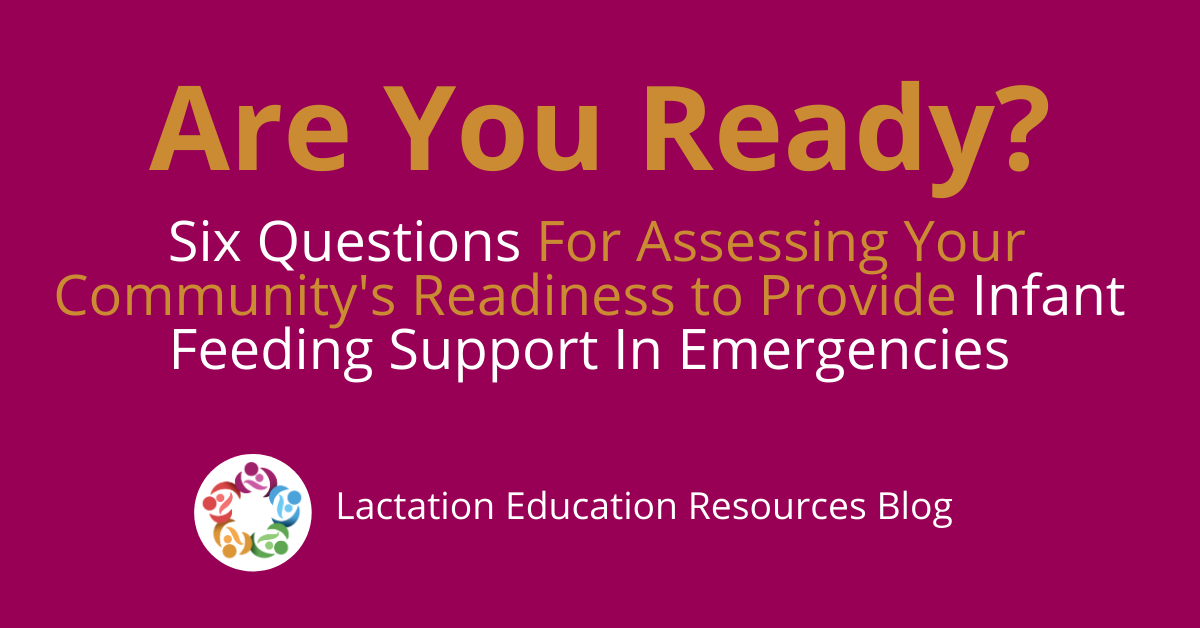Are you ready? Six questions for assessing your community's readiness to provide infant feeding support in emergencies

Is your community ready to support infant and young child feeding in emergencies? The emergence of COVID-19 has shone a light on the need for advance planning to ensure the wellbeing of the youngest people during natural and man-made disasters.
Here are six questions to explore in your community:
Can your community define IYCF-E?
IYCF-E stands for “infant and young child feeding in emergencies,” and it refers to meeting the nutritional needs of children from birth to 2 years old during a disaster. Disasters can be natural or manmade, and they can be personal or public. Examples range from hurricanes and earthquakes to the sudden homelessness of one family due to changing financial circumstances. “These various types of emergencies are similar in that they completely disrupt daily life and one’s ability to meet basic needs,” explains Malaika Ludman, MPH, CLC, doula, and instructor for Infant Ready: Infant and Young Child Feeding in Emergencies, a new online course.
Does your community have an IYCF-E plan?
Although it is often ignored in a country, state, city or province’s disaster preparedness plan, IYCF-E is critical. Globally, the total mortality rates for children under one year of age in emergencies are as high as 53 percent.
“We find that the disease and death rate among infants and young children in emergencies is high,” Ludman says. “The leading causes of illness and death are respiratory illness, diarrhea, and malnutrition. . IYCF-E merits a lot of attention, because many children are living in areas affected by emergencies. In the US, emergency response training and preparedness do very little to address infant feeding.”
Infants and young children are uniquely vulnerable in emergencies for three reasons:
- They are very susceptible to illnesses
- They can’t care for themselves
- They have very specific nutritional needs
and
Does your community hold misconceptions about breastfeeding during emergencies?
The absolute safest food for a baby during an emergency is his or her own parents’ milk. Unfortunately, misconceptions about breastfeeding during a crisis abound, and families are likely to receive these messages from the media and other sources. They may hear that parents who are under stress cannot or should not breastfeed, that malnourished mothers won’t make enough milk, and that infant formula is a better choice. If breastfeeding has been interrupted by the emergency, they may be told it can’t be started again. If a baby develops diarrhea, the family may be told to stop breastfeeding.
Does your community know the impacts of protecting breastfeeding during emergencies?
A baby who gets breastmilk during a crisis receives disease protection from a safe, accessible food source. It offers complete nutrition at the perfect temperature, keeping the baby warm and reducing stress. On the other hand, formula-fed babies are at much higher risk of infection during an emergency, due to the risk of contamination of the water, surfaces, or supplies used to mix the formula.
Take the stunning example of a flood in 2005 in Botswana. After the flood, there was an outbreak of diarrhea that took the lives of more than 500 children, most under 5 years old. Formula-fed babies were 30 times more likely to present for hospital treatment for diarrhea than breastfed babies. In one village, 30 percent of formula-fed babies died, while no breastfed babies died.
Overall, “hundreds of formula-fed babies died, compared to only a handful of breastfed babies,” Ludman says. “We assume that none of the breastfed infants in this village died because of the protective nature of breastmilk and because these infants were not exposed to contaminated formula, water, or surfaces.”
Is there a plan for assessing and supporting safe formula use?
While doing all you can to advocate for and support breastfeeding during a disaster, you also need to be prepared to effectively help non-breastfeeding families to safely feed their babies and young children. Very often, as a lactation support provider, you will have more knowledge of safe formula feeding practices than anyone else on site. “Caregivers of formula-fed infants need special attention and support because babies who cannot be breastfed during emergencies are at greater risk.”
The first step is to help the family determine whether formula feeding is necessary. When disaster strikes, unsolicited donations of breastmilk substitutes often pour in, making formula readily available and potentially attractive. But it’s important to make sure other options have been exhausted.
“Families should receive help in assessing their feeding options,” Ludman says. “The cleanest and safest food for a baby in an emergency is its mother’s own breastmilk, first from the breast, and second, from a feeding implement. The second safest choice is donor breastmilk. The third safest choice is liquid formula … and the least safe choice is powdered formula, because of the risk of infection.”
When formula is needed, lactation support professionals need to be prepared to educate families on why ready-to-use formula is safer than powdered in emergencies; supply appropriate feeding implements, clean water, fuel, and education; and offer healthcare and monitoring.
Ready to learn more?
With the New Orleans Breastfeeding Center’s 1.5-hour class, Infant Ready: Infant and Young Child Feeding in Emergencies, you will learn the basics of how to support breastfeeding and formula feeding families in any kind of crisis.
Taught by Malaika Ludman, MPH, CLC, and doula, and by Latona Giwa, BSN, RN, IBCLC, co-founder of the New Orleans Breastfeeding Center, the class delves deeply into how lactation professionals and first responders can support both breastfeeding and non-breastfeeding families during an emergency, using real-world examples and lessons from several global disasters.
The course is ideal for first responders, emergency managers, public health departments, medical volunteers, WIC offices and staff.
Infant Ready: Infant and Young Child Feeding in Emergencies
By accepting you will be accessing a service provided by a third-party external to https://www.lactationtraining.com/
